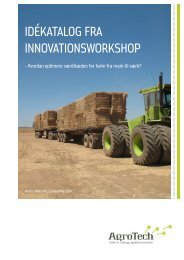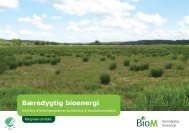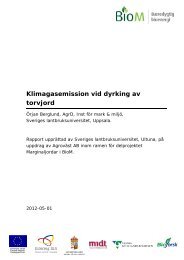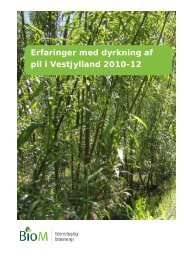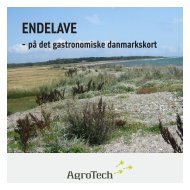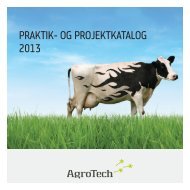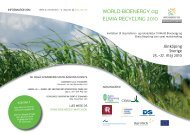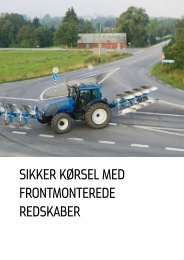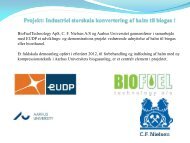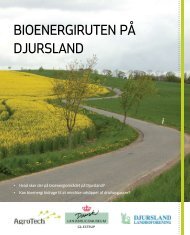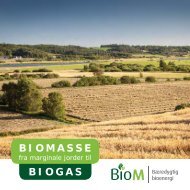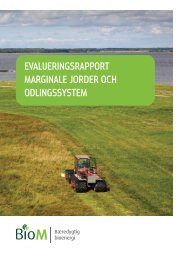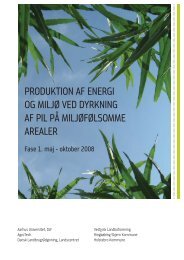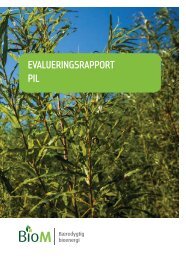Article. Energy in fokus - from Kyoto to Copenhagen. - AgroTech
Article. Energy in fokus - from Kyoto to Copenhagen. - AgroTech
Article. Energy in fokus - from Kyoto to Copenhagen. - AgroTech
Create successful ePaper yourself
Turn your PDF publications into a flip-book with our unique Google optimized e-Paper software.
Silke Hemm<strong>in</strong>g, Wagen<strong>in</strong>gen UR Greenhouse Horticulture, P.O. Box 644,<br />
6700 AP Wagen<strong>in</strong>gen, The Netherlands. E-mail: silke.hemm<strong>in</strong>g@wur.nl<br />
Towards the semi-closed greenhouse?<br />
In current greenhouse horticulture, next<br />
<strong>to</strong> high production levels, quality and<br />
timel<strong>in</strong>ess of production are important.<br />
This can be reached by optimal control<br />
of greenhouse climate for which energy<br />
is of major importance. More conditioned<br />
greenhouses are preferable. Next <strong>to</strong><br />
that the need for (energy) cost reduction<br />
has become higher, s<strong>in</strong>ce with <strong>in</strong>creas<strong>in</strong>g<br />
prices of natural gas <strong>in</strong> the last decade,<br />
energy forms a substantial fraction of the<br />
<strong>to</strong>tal production costs. The liberalisation of<br />
the energy market for Dutch growers s<strong>in</strong>ce<br />
2002 has <strong>in</strong>creased the growers awareness<br />
of the energy consumption of their cropp<strong>in</strong>g<br />
systems. This free market implies that<br />
growers do not pay a fixed price per unit<br />
of natural gas anymore, but that prices are<br />
greatly determ<strong>in</strong>ed by the maximum supply<br />
capacity of the gas contract. Therefore,<br />
it is important <strong>to</strong> reduce peaks <strong>in</strong> energy<br />
use. In view of the <strong>Kyo<strong>to</strong></strong> pro<strong>to</strong>col several<br />
governments have set goals for energy use<br />
and CO emission. In the Netherlands, the<br />
2<br />
horticultural sec<strong>to</strong>r and government have<br />
agreed <strong>to</strong> improve the energy efficiency<br />
(production per unit of energy) by 65% <strong>in</strong><br />
2010 compared <strong>to</strong> 1980 and <strong>to</strong> <strong>in</strong>crease<br />
the contribution of susta<strong>in</strong>able energy <strong>to</strong><br />
4%. Over the period 1980 – 2005, energy<br />
efficiency <strong>in</strong> Dutch greenhouse <strong>in</strong>dustry<br />
has more than doubled. However, <strong>to</strong>tal<br />
energy use per square meter of greenhouse<br />
hardly changed. Efficiency improvement<br />
resulted <strong>from</strong> a more than doubl<strong>in</strong>g <strong>in</strong><br />
yield per m2 caused by amongst others<br />
improved greenhouse transmission, cultivars<br />
and cultivation techniques.<br />
<strong>Energy</strong> <strong>in</strong> the greenhouse is primarily<br />
used for temperature control, reduction<br />
of air humidity, <strong>in</strong>crease of light <strong>in</strong>tensity<br />
and <strong>to</strong> a lesser extent for CO supply.<br />
2<br />
The use of fossil energy can be reduced<br />
by limit<strong>in</strong>g the energy demand of the<br />
system and decreas<strong>in</strong>g energy losses (higher<br />
<strong>in</strong>sulation), by <strong>in</strong>telligent control of<br />
(micro)climate, by <strong>in</strong>creas<strong>in</strong>g the energy<br />
efficiency of the crop and by replac<strong>in</strong>g<br />
fossil energy sources by susta<strong>in</strong>able ones.<br />
In this paper, recent developments concern<strong>in</strong>g<br />
reduction of energy consumption<br />
<strong>in</strong> greenhouse production systems will be<br />
presented, as well as the consequences for<br />
crop management.<br />
<strong>Energy</strong> sav<strong>in</strong>g of<br />
greenhouse systems<br />
<strong>Energy</strong> requirement of the greenhouse can<br />
be lowered by reduc<strong>in</strong>g energy losses.<br />
<strong>Energy</strong> losses occur through the ventilation<br />
as sensible and latent heat, but also<br />
through the greenhouse cover<strong>in</strong>g by convection<br />
and radiation. Us<strong>in</strong>g greenhouse<br />
covers with higher <strong>in</strong>sulat<strong>in</strong>g values and<br />
the use of energy screens highly limits<br />
the amount of energy losses. Increased<br />
<strong>in</strong>sulation can be obta<strong>in</strong>ed by modern<br />
greenhouse materials, where new coat<strong>in</strong>gs<br />
(low emission and anti-reflection) are<br />
applied. <strong>Energy</strong> sav<strong>in</strong>g of 25-30% seem <strong>to</strong><br />
be possible with the new double materials<br />
compared <strong>to</strong> a greenhouse with s<strong>in</strong>gle<br />
glass and energy screen. A prerequisite is<br />
that new <strong>in</strong>sulat<strong>in</strong>g materials should not<br />
<strong>in</strong>volve considerable light loss, s<strong>in</strong>ce this<br />
would result <strong>in</strong> a loss of production, s<strong>in</strong>ce<br />
1% additional light results <strong>in</strong> 0.8-1% more<br />
production. With new double materials<br />
loss of light is not <strong>to</strong> be expected. If additional<br />
CO 2 is applied and attention is paid<br />
<strong>to</strong> humidity control, production will not<br />
decrease, <strong>in</strong> spite of considerable energy<br />
sav<strong>in</strong>gs.<br />
Thermal screens add an additional barrier<br />
between the greenhouse environment<br />
and its surround<strong>in</strong>gs. When movable, it<br />
has less impact on the light transmission<br />
compared <strong>to</strong> fixed screens. If they are used<br />
almost permanently, screens can reduce<br />
the energy use by more than 35%, depend<strong>in</strong>g<br />
on the material. In practice, movable<br />
screens are closed only part of the cropp<strong>in</strong>g<br />
season depend<strong>in</strong>g on the criteria for<br />
open<strong>in</strong>g and clos<strong>in</strong>g. Due <strong>to</strong> restrictions<br />
for clos<strong>in</strong>g, generally enforced by criteria<br />
related <strong>to</strong> humidity and light, <strong>in</strong> commercial<br />
practice reduction <strong>in</strong> energy use by<br />
thermal screens is restricted <strong>to</strong> 20%. Efficient<br />
screen<strong>in</strong>g strategies can save energy<br />
sav<strong>in</strong>g while ma<strong>in</strong>ta<strong>in</strong><strong>in</strong>g crop production<br />
level. Delay<strong>in</strong>g the screen open<strong>in</strong>g <strong>to</strong> out-<br />
side radiation levels above 50-150 W m -2<br />
energy sav<strong>in</strong>gs can be reached <strong>in</strong> practice<br />
without production losses.<br />
Semi-closed greenhouse concepts<br />
Semi-closed greenhouse concepts contribute<br />
<strong>to</strong> energy sav<strong>in</strong>g. The last years<br />
several greenhouse concepts were developed.<br />
It started with us<strong>in</strong>g the greenhouse<br />
itself as solar collec<strong>to</strong>r (solar greenhouse<br />
“Zonnekas”), followed by fully closed<br />
greenhouses, <strong>to</strong>wards energy produc<strong>in</strong>g<br />
greenhouses (“Kas als energiebron”) and<br />
latest developments <strong>to</strong>ward electricity produc<strong>in</strong>g<br />
greenhouses (“Elkas”). In closed<br />
greenhouses, the excess of solar energy<br />
<strong>in</strong> summer is collected and s<strong>to</strong>red e.g. <strong>in</strong><br />
aquifers <strong>to</strong> be reused <strong>in</strong> w<strong>in</strong>ter <strong>to</strong> heat the<br />
greenhouse. These concepts result <strong>in</strong> a<br />
reduction <strong>in</strong> primary energy use of 33%,<br />
based on 1/3 of the area with closed<br />
greenhouse and 2/3 with traditional greenhouse<br />
with ventilation w<strong>in</strong>dows. Besides<br />
aquifers for seasonal energy s<strong>to</strong>rage, the<br />
technical concept consists of a heat pump,<br />
daytime s<strong>to</strong>rage, heat exchangers and air<br />
treatment units which either br<strong>in</strong>g the cold<br />
air directly <strong>in</strong><strong>to</strong> the <strong>to</strong>p of the greenhouse<br />
or do so via air distribution ducts below<br />
the gutters. In this concept, ventilation<br />
w<strong>in</strong>dows are closed. Thereby, CO 2 levels,<br />
temperature and humidity can be controlled<br />
<strong>to</strong> the needs of the crop. To reduce<br />
<strong>in</strong>vestment costs, <strong>in</strong> practice growers<br />
tend <strong>to</strong> choose for a semi closed system.<br />
Cool<strong>in</strong>g capacity of this system is lower<br />
than that of a closed greenhouse. Therefore,<br />
when the active cool<strong>in</strong>g capacity is<br />
<strong>in</strong>sufficient <strong>to</strong> keep the temperature below<br />
the maximum, ventilation w<strong>in</strong>dows will<br />
be opened. CO 2 emission <strong>in</strong> (semi)closed<br />
greenhouses is considerable lower than <strong>in</strong><br />
open greenhouses. In a recent experiment,<br />
<strong>in</strong> which <strong>to</strong>ma<strong>to</strong>es were grown with a CO 2<br />
supply capacity of 230 kg ha -1 h -1 up <strong>to</strong><br />
a maximum concentration of 1000 ppm,<br />
<strong>in</strong> the open greenhouse 54.7 kg CO 2 m -2<br />
was supplied whereas <strong>in</strong> the closed greenhouse<br />
this was 14.4 kg CO 2 m -2 .<br />
Specific characteristics of climate <strong>in</strong><br />
36 ENERGY IN FOCUS



